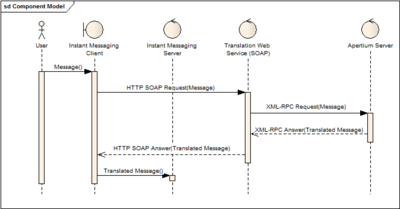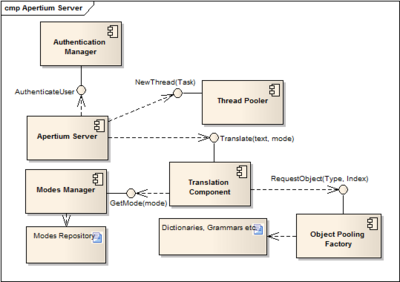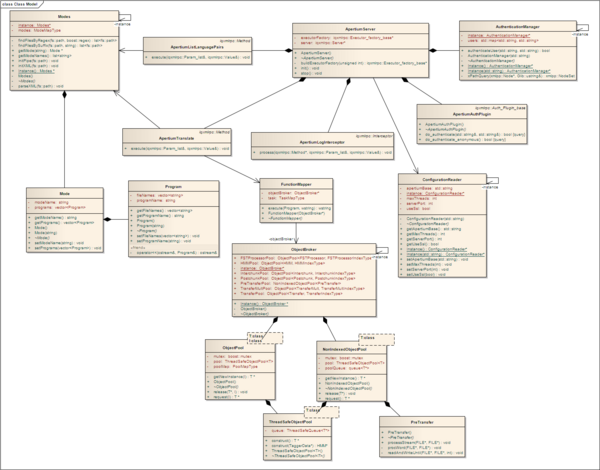Difference between revisions of "Apertium going SOA"
| Line 56: | Line 56: | ||
== Development status - 22/05/2009 == |
== Development status - 22/05/2009 == |
||
[[Image:ApertiumServerClassModel22052009.png| |
[[Image:ApertiumServerClassModel22052009.png|600px]] |
||
Revision as of 14:39, 24 May 2009
Contents
Introduction
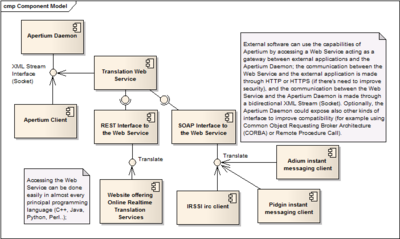
The aim of this project is to design and implement a Client-Server architecture for Apertium.
Actually, to translate a big corpus of document, many Apertium processes are created and each one must load the required transducers, grammars etc., causing a waste of resources and, so, a reduction of scalability.
To solve this problem, a solution is to implement an Apertium Service that doesn't need to reload all the resources for every translation task. In addition, this kind of service would be able to handle multiple request at the same time (useful, for example, in a Web 2.0-oriented enviroment), would improve scalability, and could be easily included into existing business processes and integrated in existing IT infrastructures with the minimum effort.
In addition, this project aims also to implement a Web Service acting as a gateway between the Apertium Server and external applications (loading Apertium inside the Web Service itself would be nonsense, since a Web Service is stateless and it wouldn't solve the scalability problem): the Web Service will offer both a SOAP and a REST interface, to make it easier for external applications/services (for example: IM clients, web sites, large IT business processes..) to include translation capabilities without importing the entire Apertium application.
A possible Use Case: an Healthcare organization
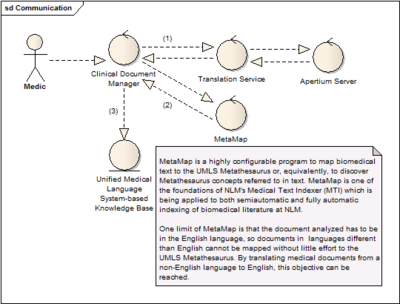
In Healthcare Information Systems (HIS), to improve external services' access and integration, there's a general trend to implement IT infrastructure based on a SOA (Service-Oriented Architecture) model; in this use case, I show how an Healthcare Organization of non English speaking countries can greatly benefit of the integration of a Translation Service implemented using Apertium in their IT infrastructure.
MetaMap is an online application that allows mapping text to UMLS Metathesaurus concepts, which is very useful interoperability among different languages and systems within the biomedical domain. MetaMap Transfer (MMTx) is a Java program that makes MetaMap available to biomedical researchers. Currently MetaMap only works effectively on text written in the English language, which difficult the use of UMLS Metathesaurus to extract concepts from non-English biomedical texts.
A possible solution to this problem is to translate the non-English biomedical texts into English, so MetaMap (and similar Text Mining tools) can effectively work on it.
Service's Interface
A possible interface for the Apertium service's functionalities is based on XML-RPC, a remote procedure call protocol which uses XML to encode its calls and HTTP as a transport mechanism. The XML-RPC standard is described in detail here: http://www.xmlrpc.com/spec
The list of methods the Apertium RPC service will expose will be probably similar to the following:
- array<string> GetAvailableModes();
- string Translate(string Message, string modeName, string inputEncoding);
TODO: add methods to get Server's current capabilities and load; this is useful to implement some kind of load balancing in the case of a cluster of Apertium Servers
Service's internals
A possible efficient and scalable implementation of an Apertium Server can be composed by the following components:
- Authentication Manager: it's needed to authenticate users (using basic HTTP authentication) and it can be interfaced, for example, to an external OpenLDAP server, a DBMS containing users' informations, etc.
- Thread Pooler: an implementation of the Thread Pool pattern: http://en.wikipedia.org/wiki/Thread_pool
- Modes Manager: locates modefiles and parses them in the corresponding sets of instructions
- Object Pooling Factory: an implementation of the Object Pool pattern: http://en.wikipedia.org/wiki/Object_pool
- Translating Component: using the instructions contained in a mode file (parsed by the Modes Manager component), translates a given text encoded in a certain language into another.
